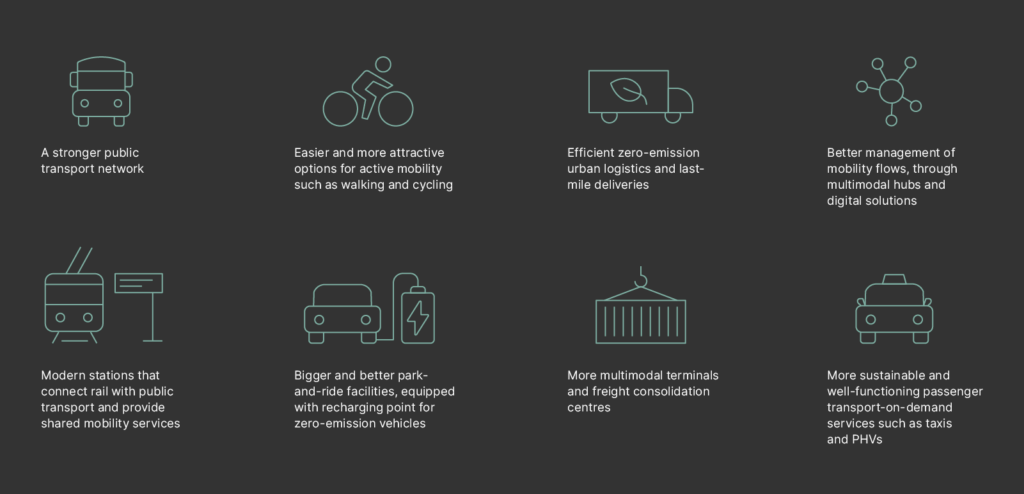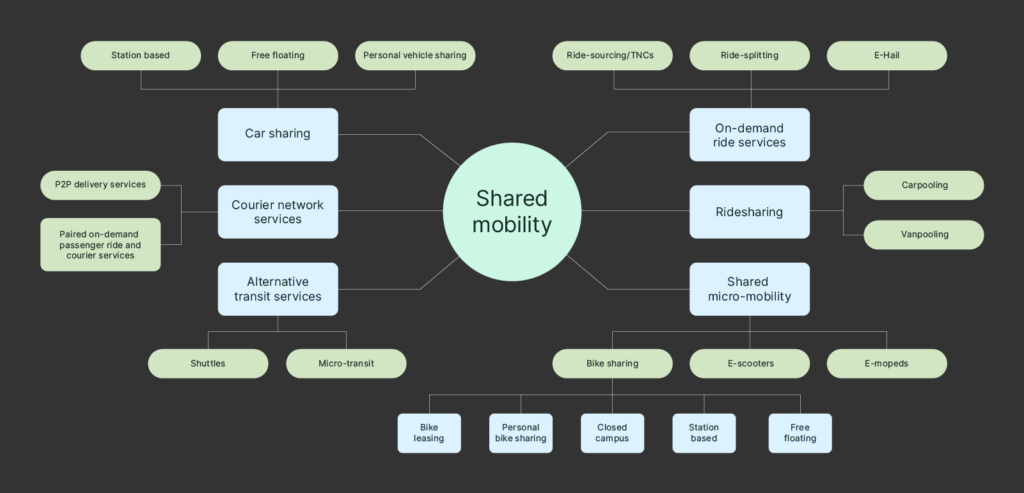The global automotive industry is undergoing a fundamental shift from personally owned, driver-driven vehicles to a future mobility system that is centered around driverless vehicles and shared mobility.
Shared mobility is the concept that covers short-term sharing of different means of transportation to provide access to on-demand vehicles and, therefore, bridge the gap between public transport and private vehicles. Based on the research conducted by the Shared-Use Mobility Center, people who use shared modes are more likely to use mass transit, own fewer cars, and spend much less time on transportation generally.
To solve the challenges urban areas are facing, automotive mobility providers have to work closely with both public and private sectors to create a mobility strategy that integrates new emerging technologies and considers factors like population density, street network type, and public transport options.
In this article, Ivan Popović, Director of Engineering and Delivery with a focus on automotive and collaboration with OEMs, dives deeper into the trends, risks, and the future of shared mobility.
What are the benefits?

Besides contributing to a greener future, a shared mobility strategy unlocks numerous opportunities and solutions.
Greener environment
With ambitions to meet Paris Agreement goals, shared mobility represents a viable alternative to improving urban mobility and achieving Net Zero goals. Shared mobility lowers the amount of personal vehicle ownership, which minimizes carbon emissions and reduces congestion, energy consumption, and pollution.
Shared mobility companies are already employing various strategies to minimize their carbon footprint, from organized transportation and promoting cycling, carpooling, and electric bikes to creating potential for environmentally friendly shared vehicles.
Building intelligent routing models can significantly contribute to sustainability goals by giving drivers the best tips and tricks on how to best arrive at the desired destination and, therefore, reduce the time spent on the road, cost, and carbon emissions.
Accessibility and ease of use
Shared mobility can help passengers improve their socio-economic status. While passenger cars require expensive lease schemes and huge capital investments, shared mobility does not require the end user to invest so much. Users will only pay for what they need to get from point A to point B. On top of this, shared mobility can improve transportation in areas where public transport is scarce.
Land use
Parking is a huge issue in cities across the globe. With shared mobility, cars spend more time in motion and are parked less often, which leads to a lowered need for parking spaces.
Reduced congestion and journey times
Besides fewer parking places, congestion is another big challenge car drivers in cities face. On average, drivers in the UK lose 178 hours a year due to congestion, which is associated with a cost of £8 billion. Shared micromobility (e-scooters, e-bikes, and conventional pedal bikes) is one way to solve this challenge. Also, dockless vehicles, which can be parked anywhere, and car clubs, which reduce the number of vehicles on the roads (one vehicle replaces 8 to 12 privately owned vehicles) further reduce the journey time and ease the pressure on parking as well as congestion.
Reduced living costs and improved well-being
Studies have shown that average car users utilize their vehicles for only 9 hours per week, which means that the car spends 159 hours sitting idle in a parking lot or driveway. By relying on shared mobility, obligations and financial stress that come with private car ownership are significantly reduced. On top of this, shared mobility encourages both commuters and drivers to opt for healthier mobility options.
According to McKinsey’s survey, respondents single out convenience as the number one reason for using shared mobility, which proves why e-hailing is a more dominant mode than other shared mobility nodes.
Key trends
Despite strict regulations imposed by the pandemic (such as physical distance), shared mobility is making its comeback. In the last couple of years, new modes and services have emerged, such as peer-to-peer car sharing, ridesharing with other passangers, and shared electric scooters. One of the next biggest things coming to the shared mobility market is autonomous taxis, or so-called robo-taxis and airborne varieties.
The seven verticals of shared mobility are:
- E-hailing — A driver orders a car to pick them up using a virtual device. The driver picks up a customer and drives them to the designated address.
- Dynamic shuttle services and pooled e-hailing — Riders order a drive and share the ride with other passengers. The driver of an ordered car picks up the passengers and drives them to their drop-off points in an optimized order.
- Car sharing — In this mode, customers use the company’s car for a shorter period of time than when renting it. These sharing models can be station-based or free-floating (cars can be picked up and dropped off anywhere).
- Peer-to-peer (P2P) car sharing and ridesharing — While in car sharing, car owners allow other drivers to use their cars for a charge; in ridesharing, car owners drive passengers to their destination.
- Shared micro-mobility — These vehicles include very light vehicles like kick scooters, electric scooters, and bicycles, which the public can use for a fee.
- Aerial mobility — Flying taxis that will move people between dedicated stations and can be either semiautonomous or piloted.
- Robo-taxis and shuttles — These modes resemble today’s taxi services and e-hailing but leverage autonomous-driving technology with a human. Many companies globally are investing in this shared mobility model as it can become quite competitive to driver-based services.

There’s so much going on in the world of shared mobility—it seems it’s only getting stronger. Let’s dive deeper into the current hottest trends that are reshaping the future of shared mobility space.
Mobility-as-a-Service (MaaS)
Mobility-as-a-Service, also known as Mobility on Demand, integrates various modes of transportation into one service. Users can use one application to plan their trips using different modes of transportation. They can choose between ready-made solutions on how to get to their desired destination using their mobile phones, where the chosen routes are based on all available modes and current traffic jams.
They choose the option that perfectly meets their needs (in terms of time, cost, and distance) and pay for it using one account. MaaS is a core differentiator that potential cities need to enable as it can improve access and, therefore, optimize travel across the globe.

Autonomous within the sharing ecosystem
Autonomous vehicles can improve the operational efficiency of shared mobility operations. One challenge that operators currently face, regardless of whether it is car sharing, scooter sharing, or something in between, is rebalancing the fleet and ensuring there is enough supply of vehicles to meet the demand at various locations. Currently, this is a manual, labor-intensive effort. However, if vehicles could drive themselves to a different location, that could improve the overall availability in popular areas and become an even more reliable and convenient mobility option for users.
Micro-mobility
Micro-mobility is another key player in the shared mobility model and is gradually gaining in popularity globally as it brings various convenience and environmental benefits. E-bikes are one of the most convenient forms of daily commuting and there are many different game-changing micro-mobility software solutions that enable accurate tracking and navigation specifically for pedal and electric bikes and e-scooters.
Risks
Shared mobility is not a new concept—the idea has been developing since the 1940s. However, the field has grown immensely ever since. Despite the value it can bring to the well-being of the community and predictions that it will become an alternative for vehicle ownership, there are still concerns that raise a question – is shared mobility moving in the right direction?
Here are a few risks that may cause shared mobility to fail to deliver on promises:
Car sharing is still not profitable
The ultimate goal mobility companies are trying to achieve is profitability. However, there may be some challenges companies face on this path. Although end-users feel that shared mobility services perfectly answer their requirements, they are not aware of the operational challenges companies are dealing with daily. To be able to provide a stellar experience, mobility companies need to offer high-quality and flawless user apps, and vehicles always need to be easy to rent and unlock and available where demand for mobility is high. If end-users face technical issues, they will lose trust and look for some other service provider.
Consumers will need to shift their mindset to more convenient and environmentally friendly modes of transport
The growth of shared mobility requires a consumer mindset shift towards more convenient, cost-efficient, and more environmentally friendly modes of travel over having privately owned cars. According to research, private cars are still the most popular mobility mode among drivers despite rising shared mobility services. One of the reasons people are still heavily relying on their own cars is a deeply ingrained desire to own a car. However, drivers are also seeking a more enjoyable mobility experience, which is why they are increasingly open to shifting their transportation habits.
Infrastructure should advance to respond to shared mobility trends
Urban mobility brings a number of challenges and involves multiple transport modes, including public transport networks and road infrastructure, as well as many different stakeholders like city councils, governments, and service providers. Leveraging technologies to increase the functional safety of autonomous vehicles and enable their easier and smoother navigation through the city is simply not enough. To provide safe shared mobility services, it is critical to enable infrastructure advancement to improve the functioning of such vehicles and ensure that the data exchange between users and the infrastructure must comply with local privacy and data protection regulations.
Waymo and Tesla have a front seat in safe shared mobility. They both share the same goal: to create an autonomous vehicle that will ensure safe driving and decrease the number of deaths on the road. Waymo is slowly rolling out autonomous vehicles in the form of a robo-taxi service, and Tesla has rolled out autonomous features more quickly. In the company’s words, the hardware in the new Teslas is capable of “full self-driving in almost all circumstances” and is “designed to be able to conduct short and long distance trips with no action required by the person in the driver’s seat.”
Reactive approach
Vehicle utilization has limits, especially during the night or repair. To be able to meet demand, the company needs to make sure the vehicles are in the right place at the right time. Otherwise, it may put additional strain on the company’s profit. Identifying and meeting the demand requires a proactive approach and being able to predict where the demand will be.
Faulty fleet management
If operations and processes are rather reactive instead of proactive, fleet management is directly impacted. Without having relevant data on demand at a certain place and time, weather, parking regulations, etc., fleet operators are wandering in the dark with no navigation to lead them in the right direction.
While, on the one hand, it can bring the future of mobility to a halt, it can also trigger some major developments that will drive fundamental changes in shared mobility. As people started to avoid public transport, cities started investing their resources in creating more space for scooters and bikes.
On top of this, governments started the incentive to encourage the automotive industry to use carbon-neutral solutions and stimulate the use and development of EVs. Also, consumers have started turning to digital channels more and more, and they now expect mobility players to expand their online services.

Smart shared mobility solutions can transform city living and enhance quality of life. However, implementing these solutions at scale can be difficult. A collaborative approach could be the way ahead.
– Ivan Popović
Director of Engineering and Delivery, Automotive Lead
What’s next for shared mobility
The future of mobility promises seems bright – seamless, automated, personalized travel on demand.
The hailed-mobility market is expected to grow
E-hailing, alternatively known as ride-hailing, refers to a service that enables individuals to reserve public transportation options using electronic applications. This encompasses a range of offerings, including e-hailing vehicles and taxis. An e-hailing vehicle pertains to a privately owned car utilized for providing public transportation to passengers who make bookings via electronic applications. The hailed-mobility market is expected to grow 13 to 19 percent each year by 2030. Some countries, such as Norway, have even removed entire parking zones so that they would encourage drivers to use pooled mobility services.
Shared cars may see additional competition by 2030
With robo-taxis gaining traction, they might offer a more convenient and affordable shared-mobility option than car sharing. Besides having to find parking, car sharing users may struggle with overcoming the first and last-mile gaps.
Electric and shared AVs such as robo-taxis or shuttles could solve mobility’s pain points in cities
There will be less road congestion and no more crowded parking spaces. All of this would lead to less pollution and easier access to a more affordable, more efficient, environment and user-friendly urban mobility.
Shared micro-mobility will keep rising
Free-floating shared micro-mobility with regular bikes, e-bikes, e-scooters, and e-mopeds will expand to more than 50% of European cities since the trend started. According to the forecast, there should be more than 600,000 shared flee-floating vehicles on the streets of European cities, which will largely contribute to sustainability and travel time and costs.
Urban air mobility is gaining momentum
Opportunities to increase road capacity are on the decrease. Urban aerial mobility (UAM) is unlocking new opportunities for increasing traffic capacity and reducing traffic congestion. However, many questions emerge, such as: what would be the UAM’s network structure? What transportation benefits does it bring? UAM could also be limited by airspace management needs and the infrastructure.
The success of shared mobility will depend on a number of different factors
Especially until 2030, the future of mobility will depend on policies and regulations issued by governments, customer adoption, and technological advancements. Industry players will provide users with more cost-efficient alternatives to taxis and public transportation. The main factors to be considered will be customer convenience and affordability. This would result in a faster introduction of robo-taxis and other green solutions and enable e-hailing and MaaS companies to offer different options that would improve customer experience.
OEMs will move from production only to selling services
The shared mobility model will offer OEMs an opportunity to stop selling products and start selling services: one of the most promising sectors today is connected carsharing and mobility as a Service (MaaS). With these trends, automakers will get an opportunity to move into the profitable markets of transportation and mobility—carsharing can enable OEMs to increase their future mobility offerings and capture additional revenue.
How can HTEC Group help you succeed in tomorrow’s mobility ecosystem?
Smart shared mobility solutions can transform city living and enhance quality of life. However, implementing these solutions at scale can be difficult. A collaborative approach could be the way ahead.
HTEC has a long and successful history in building next-gen, software-defined vehicle solutions for some of the most innovative companies in the world of automotive including premium OEMs, Tier 1, and chip suppliers.
From delivering future-proof solutions that accelerate towards EV production to creating new functions and capabilities that help create vehicles with different levels of autonomy, the HTEC team, with expertise in powertrain domain, including electric motor control, power inverters and battery management systems, ADAS engineering, high-performance code, data fusion, root planning and optimization, simulation, data engineering and building ML and AI algorithms, is empowering the future of shared mobility.
Driven by our mission to get out of our comfort zones and search for innovative solutions to some of the world’s most complex problems, our team of skilled domain experts is here to help you navigate your digital journey towards a more connected and digitized world. Connect with Ivan Popovic to learn how we can help you get beyond the wheel.
Learn more about how we can help you empower the future of mobility here.
Learn more about how we help spark the electric vehicle revolution here.
Learn more about how we can help you unlock new business value from autonomous driving here.






